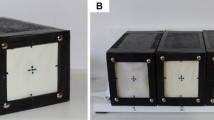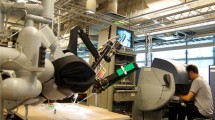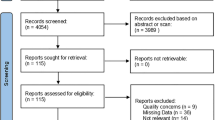Abstract
Objective
The lack of haptic feedback (HF) in robotic surgery is one of the major concerns of novice surgeons to that field. The superior visual appearances acquired during robotic surgery may give clues that make HF less important.
Methods
We surveyed 52 individuals on their perception of HF during robotic surgery. The first group of 34 surgically inexperienced people used the da Vinci robot for their first time (drylab). The second group included 8 laparoscopic surgeons with experience up to a fifth robotic operation. The third group included 10 surgical experts with substantial experience (150-650 robotic cases). Visual analog assessment was made of perception of HF, how much HF was missed, how much the absence of HF impaired the operators’ level of comfort. Robotic experts were asked if complications have occurred as a result of a lack of HF.
Results
Of the first group, 50% reported the perception of HF, as did 55% of the second group and 100% of the third group (difference between group 1 and group 3: p < 0.05). The first group missed HF for 6.5; the second group for 4.3, and the third group for 4 (difference between groups 1 and 3: p < 0.05). The surgical experts claimed to have missed HF for 7.2 s when they first started robotic surgery (Difference to now: p < 0.05). The lack of HF caused discomfort for the first group of 4; for the second group of 4,4, and for the third group of 2,6. One complication was reported by the robotic experts as resulting from the lack of HF.
Conclusions
The data support the conclusion that even beginners quickly experience the perception of HF when performing robotic surgery. With more experience, perception of HF and the level of comfort with robotic surgery increases significantly. This perception of HF makes “real” HF less important and demonstrates that its importance is overestimated by novices in robotic surgery.
Similar content being viewed by others
Avoid common mistakes on your manuscript.
In daily life, human orientation is naturally based on visual, auditory, olfactory, and tactile information. The cerebral cortex of the brain quickly processes those inputs and allows people to manipulate their surroundings with facility if all parameters are available [1]. During operations, surgeons work primarily with visual and tactile clues. Those clues are readily available in open surgery, and visual impulses in particular can be improved by different measures such as magnifying glasses or light optimization. In recent years, surgery has incorporated more and more minimally invasive strategies, which have modified sensory stimuli for the surgeon. The first step toward minimally invasive surgery was the implementation of laparoscopy into clinical routine. In laparoscopy, both visual (shaky 2-D-image, suboptimal exposure) and tactile clues (no manual touch of tissue possible, only acquired through instrumentation) are limited as compared to open surgery. Still, in laparoscopy, some haptic feedback is preserved, and surgeons are able to interpret texture, shape, and consistency of objects by touching with the instruments [3, 4].
We are now facing the “post-laparoscopic era”: robotic surgery is a rapidly growing field, and it will potentially replace laparoscopy in the long term. The only available surgical robot on the market is the da Vinci® Surgical System by Intuitive. This system delivers a high-quality, magnified, surgeon-controlled 3-dimensional, stable image, and it contains instruments that allow intuitive control by the surgeon, with tremor reduction, motion scaling, and wrist movements [2]. Because of these characteristics, the da Vinci® robot was studied for its ability to overcome the technical limitations of traditional laparoscopy and to restore the handling of open surgery [6]. Where vision is concerned, the system succeeded completely, and even exceeded open surgery, because the 3-dimensional image of the da Vinci® Surgical System is superior to any “natural” visualization without any visual aids. As the latest step toward enhancing visualization, high-definition imaging integrated into the da Vinci® Surgical System is commercially available since this year.
However, despite superior visualization, the da Vinci® robot does not provide haptic feedback to the surgeon. Because tactile ability is an essential element of surgery, many concerns arise when there is a complete lack of tactile feedback in robotic surgery [5, 7, 8, 10, 12]. It is evident that scientific effort will be required to develop devices that provide the surgeon with haptic feedback, but this feature is not expected to be commercially available for the da Vinci® robot in the near future [9, 11]. Nevertheless, experienced robotic surgeons do not complain about the lack of haptic feedback, and no reports of complications resulting from lack of haptic feedback appear in the literature.
How is it that robotic surgeons compensate for the lack of tactile sensation? After we became familiar with the da Vinci® Surgical System as it was implemented into our clinical routine, we hypothesized that the superior visual clues substitute for “real” haptic feedback by creating the perception of haptic feedback. In other words, with experience, the surgeon at the console “learns” to translate optics into tactiles subconsciously and is able to use this information in the course of the procedure. Such a phenomenon would resemble a neurological form of conditioning that would obviate the need for haptic feedback devices in robotic surgery.
Material and methods
We surveyed 52 people on their perception of haptic feedback when performing robotic surgery. Probands were divided into three groups:
group 1 contained 34 surgically inexperienced students and surgeons of all levels using the da Vinci Surgical System for the first time in a dry lab; 18 were either medical students or young residents without any laparoscopic experience, and 16 were laparoscopically experienced surgeons and senior residents. Median age for all probands in group 1 was 36 (range: 17 to 56) years. Each proband spend about 45–60 min at the surgical console performing three different tasks 10 times each. The first task was to pick up a small rubber ring and place it over three different rubber peaks. This task was classified as “easy.” The second task was to take a needle and to make one stitch with one double knot. This task was classified as “medium.” Task 3, the “difficult” one, was to pick up a needle and drive it through a relatively small hook three times. Immediately after completion of all three tasks, all participants were asked to complete a questionnaire with the following content:
-
Did you experience the perception of haptic feedback while using the robot?
-
How much did you miss the feeling of haptic feedback?
-
How much does a lack of haptic feedback make you uncomfortable with the robot?
All questions except the second (which required a yes/no reply) were answered with a visual analog scale of 1 for “not at all” to 10 for “very much.”
The second group of surgeons included eight experienced laparoscopic surgeons who were using the robot in their first to fifth robotic operation on a patient. As a result of repeat robotic procedures by two of the surgeons, we were able to collect 15 questionnaires (one surgeon completed 5 procedures, another completed 4, and all the others completed 1 operation). The procedures included 9 cholecystectomies, 3 Nissen procedures (1 with a Heller myotomy), 1 sigmoid resection, 1 total mesorectal excision, and 1 gastric bypass.
Immediately after the procedures, all surgeons were asked to complete the same questionnaire used by group 1 surgeons. In addition, complications associated with the lack of haptic feedback were noted during the procedure in a prospective fashion.
The third group of surgeons included 10 experts from different geographic areas (US and Europe) and various surgical subspecialties (two pediatric surgeons, four urologists, four abdominal surgeons). All of them had substantial experience of robotic surgery (150–650 cases). All surgeons in group 3 had started robotic surgery between the years 2000 and 2003. A slightly modified questionnaire with the following content was completed by all members of this group:
-
Do you experience the perception of haptic feedback while using the robot?
-
How much do you miss haptic feedback while using the robot now?
-
How much did you miss haptic feedback when you first started robotic surgery?
-
How much does the lack of haptic feedback make you uncomfortable with the robot?
-
Do you experience the perception of haptic feedback more at certain parts of operations?
-
Did you ever have problems or complications due to the lack of haptic feedback?
All questions, except the first (which required a yes/no reply) and the fifth (which elicited free comment), were answered with a visual analog scale of 1 for “not at all” to 10 for “very much.”
Data from groups 1 and 2 were collected prospectively; group 3 reported their experience retrospectively. Comparison between groups was made with the t-test. A p < 0.05 was assumed to offer statistical significance.
Results
Seventeen of 34 probands in group 1 reported the perception of haptic feedback in their first use of the robot. There were practically no differences between inexperienced probands and laparoscopic surgeons. Four of the eight surgeons in group 2 had the perception of haptic feedback in their first operation on a patient. One of the surgeons doing more than one procedure developed the perception of haptic feedback after three operations. All of the substantially experienced robotic surgeons (group 3) reported the experience of perceiving haptic feedback (difference between group 1 + 2 and group 3: p < 0.05).
On the visual analog scale, the first group missed HF for 6,5; the second group for 4,3, and the third group for 4 (difference between groups 1 and 3: p < 0.05). The surgical experts claimed to have missed haptic feedback for 7,2 when they first started robotic surgery (difference to now: p < 0.05).
The lack of haptic feedback caused discomfort for the first group of 4; for the second group of 4,4, and for the third group of 2,6 (All differences: p > 0.05). Furthermore, one of the robotic experts stated that he experiences the perception of haptic feedback especially while grasping and another while suturing.
Because of the lack of haptic feedback, one minor complication out of an allocated number of 2,350 procedures, perforation of the gallbladder, was reported by the robotic experts.
Conclusions
The data support the conclusion that even beginners, both surgically and with the robot, quickly experience the perception of haptic feedback while performing robotic surgery. Surgeons with substantial experience in robotic surgery all perceive haptic feedback. It appears that, with more experience, perception of haptic feedback increases significantly and haptic feedback is less frequently missed. Beginners in a dry lab miss haptic feedback more than surgeons with substantial experience in robotic surgery. Potentially, specific tasks, such as grasping and suturing, enhance the perception of haptic feedback. A noticed lack of haptic feedback obliviously creates a certain amount of discomfort for the robotic surgeon. With increased perception of haptic feedback discomfort diminishes.
These data indicate that the perception of haptic feedback appears to be a frequent and very important phenomenon in robotic surgery, but so far one that is rarely recognized. How can we explain this entity of “perception of haptic feedback” in robotic surgery? For certain, the robot offers superior visual clues when compared to open and laparoscopic surgery. These visual clues, in our opinion, are accountable for the initiation of the perception of haptic feedback. Mental pictures such as alignment and tension of suturing material, discoloration and deformation of bowel during grasping, and tension of anatomical structures are familiar to all surgeons and are connected in the surgeon’s brain with a certain “feeling”; because the surgeon roughly knows from open and laparoscopic surgery how much force is applied in the performance of various techniques. These connections definitely are more developed in experienced surgeons; in other words, an advanced surgeon “knows” how a certain grip on a piece of bowel leading to a certain amount of discoloration would “feel.” In robotic surgery, these experiences are used for creation of an “artificial” tactile sensation in the brain. Most likely, perceived pictures during the robotic operation become subconsciously connected to a previously learned haptic feeling during open or laparoscopic surgery. This phenomenon supposedly happens in the cortex of the brain and is initially not consciously realized by the surgeon. We posit that this effect is some form of cortical conditioning. Unfortunately, no fundamental research on this topic could be found in the literature. We therefore assume that this phenomenon is not yet widely recognized in the medical world. Nevertheless, the perception of haptic feedback seems to be a very effective mechanism in robotic surgery, and all surgeons performing robotics will sooner or later experience this “fake” tactile sensation.
The single reported minor complication in 2,350 robotic procedures by 10 different surgeons also underlines the efficiency of perceived haptic feedback while surgeons are performing robotic procedures. These results potentially make “real” haptic feedback a fairly unimportant feature and one that is overestimated by novices in robotic surgery.
With these data against the background of increased costs, we do not think a device for haptic feedback is necessary in robotic surgery. Nevertheless, this phenomenon can work only under vision, and for that reason, robotic surgery should never be performed without visual control. As soon as instruments, intentionally or unintentionally, are moved out of the surgeon’s field of vision, inadvertent injuries may easily result, and they could go unrecognized by the surgeon.
The data from this study cannot demonstrate if robotic procedures are even easier, safer, and more comfortable for surgeons, especially for beginners equipped with a device that provides “real” haptic feedback. Also, the mechanism of creation of the perception of haptic feedback, and its potential for commercialization (e.g., a haptic feedback device in the form of a brain chip or cap) is not yet understood and remains subject to further research.
References
Akamatsu M, MacKenzie IS, Hasbroucq T (1995) A comparison of tactile, auditory, and visual feedback in a pointing task using a mouse-type device. Ergonomics 38:816–827
Ballantyne GH, Moll F (2003) The da Vinci telerobotic surgical system: the virtual operative field and telepresence surgery. Surg Clin North Am 83:1293–304, vii
Bholat OS, Haluck RS, Kutz RH, Gorman PJ, Krummel TM (1999) Defining the role of haptic feedback in minimally invasive surgery. Stud Health Technol Inform 62:62–66
Bholat OS, Haluck RS, Murray WB, Gorman PJ, Krummel TM (1999) Tactile feedback is present during minimally invasive surgery. J Am Coll Surg 189:349–355
Kaul S, Shah NL, Menon M (2006) Learning curve using robotic surgery. Curr Urol Rep 7:125–129
Kim HL, Schulam P (2004) The PAKY, HERMES, AESOP, ZEUS, and da Vinci robotic systems. Urol Clin North Am 31:659–669
Kitagawa M, Dokko D, Okamura AM, Yuh DD (2005) Effect of sensory substitution on suture-manipulation forces for robotic surgical systems. J Thorac Cardiovasc Surg 129:151–158
Maniar HS, Council ML, Prasad SM, Prasad SM, Chu C, Damiano RJ (2005) Comparison of skill training with robotic systems and traditional endoscopy: implications on training and adoption. J Surg Res 125:23–29
Omata S, Murayama Y, Constantinou CE (2005) Multi-sensory surgical support system incorporating, tactile, visual and auditory perception modalities. Stud Health Technol Inform 111:369–371
Rassweiler J, Safi KC, Subotic S, Teber D, Frede T (2005) Robotics and telesurgery—an update on their position in laparoscopic radical prostatectomy. Min Invas Ther Allied Technol 14:109–122
Sim HG, Yip SKH, Cheng CWS (2006) Equipment and technology in surgical robotics. World J Urol 24:128–135
Tholey G, Desai JP, Castellanos AE (2005) Force feedback plays a significant role in minimally invasive surgery—results and analysis. Ann Surg 241:102–109
Author information
Authors and Affiliations
Corresponding author
Rights and permissions
About this article
Cite this article
Hagen, M.E., Meehan, J.J., Inan, I. et al. Visual clues act as a substitute for haptic feedback in robotic surgery. Surg Endosc 22, 1505–1508 (2008). https://doi.org/10.1007/s00464-007-9683-0
Received:
Accepted:
Published:
Issue Date:
DOI: https://doi.org/10.1007/s00464-007-9683-0




